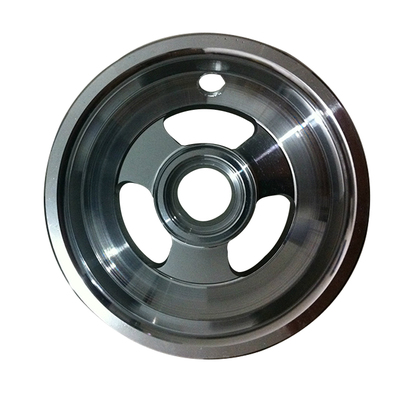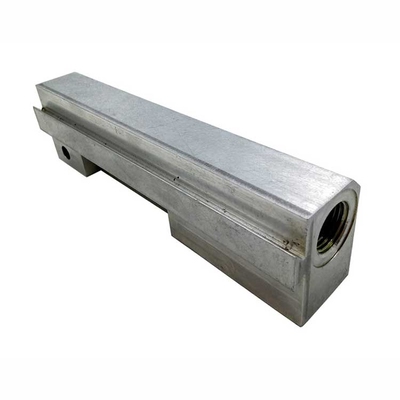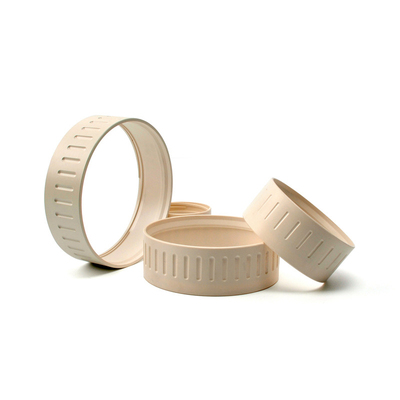[Processing Technology] Causes of metal hydrogen embrittlement and methods f removing hydrogen embrittlement
Hydrogen embrittlement is the polymerization of hydrogen dissolved in steel into hydrogen molecules, causing stress concentration, exceeding the strength limit of the steel, and forming small cracks in the steel, also known as white spots.
Hydrogen embrittlement mainly occurs on low-alloy high-strength steel, stainless steel and elastic parts. The main cause of hydrogen embrittlement is surface treatment. Hydrogen generated during the treatment of parts such as electroplating and nitriding penetrates into the metal and leads to disordered lattice arrangement. , Produce distortion, cause internal stress to increase, make the metal or the coating brittle, and cause the fracture of the parts or the peeling of the coating.
In the process, hydrogen embrittlement needs to meet two conditions: the metal has a higher hydrogen content; there is a certain external force. Due to the characteristics of hysteresis cracking caused by hydrogen embrittlement, it seriously affects the performance of parts and components, and there is a greater safety hazard. Therefore, in the design and processing of parts, especially hydraulic components working under high pressure, strict control is required.
1. Applicable scope and process of dehydrogenation embrittlement treatment
Not all metals will produce hydrogen embrittlement during surface treatment. According to research data and practice, hydrogen embrittlement mainly occurs in the following materials after surface treatment of parts.
(1) Heat-treated carbon steel and alloy steel parts with tensile strength above 981N/mm2 (or hardness above 38HRC).
(2) Parts of spring steel (including piano wire, oil tempered steel wire, and high-carbon steel wire) with a hardness of 370HV or more.
(3) Martensitic stainless steel products with a tensile strength of 1236N/mm2 or more (or 36HRC or more) that are heat-treated.
In the current processing, the main processes that can cause hydrogen embrittlement are pickling, electroplating, nitriding, and electrolysis. When the above processes are processing the surface of the parts, hydrogen will be generated and penetrated into the parts, resulting in hydrogen embrittlement.
2. Case analysis of hydrogen embrittlement
Hydraulic products generally need to work under high pressure, and some parts bear greater force. When the parts absorb hydrogen, they will break at the weak points, as shown in Figure 1. The valve core is shown in Figure 1. The inside of the valve core is hollow. Due to functional requirements, the hollow part needs to be matched and sealed with the check valve. The valve core is working at high pressure. This requires strong impact resistance and toughness at the matching part of the check valve, and at the same time, in order to achieve a certain Many manufacturers choose this kind of valve core surface chromium plating treatment, and the required plating layer is relatively thick, but due to the low current efficiency of the chromium plating process itself, it needs a long time for electroplating and serious hydrogen permeation.
The valve core material is 42CrMo, the hardness after quenching and tempering is 32~36HRC, and the thickness of the chrome plating layer is 0.04~0.06mm after assembly. The spool is used for hydraulic excavators, with a rated working pressure of 31.3MPa. And due to the characteristics of the excavator, the peak impact pressure can reach more than 60MPa. The spool has no hydrogen embrittlement treatment after electroplating, so it occurs after a period of use on the excavator. Fracture, as shown in Figure 2.
After the fracture occurred, physical and chemical analysis was carried out on the valve core. The actual hardness of the valve core was 34.5HRC, and the metallographic analysis of the cross section of the valve core before and after electroplating was done, as shown in Figure 3 and Figure 4. It can be seen from the crystal phase diagram 4 that there is an obvious feature of intercrystalline fracture in the crystal phase diagram of the valve core after electroplating-a rock sugar-like fracture.
![[Processing Technology] Causes of metal hydrogen embrittlement and methods of removing hydrogen embrittlement [Processing Technology] Causes of metal hydrogen embrittlement and methods of removing hydrogen embrittlement](/upload/image/20211023/20211023031034_92957.jpg)
3. Measures and prevention of hydrogen embrittlement
To remove the hydrogen embrittlement caused by the adsorption of hydrogen on the parts, the drying process is generally selected, and the drying process is generally divided into:
(1) General drying treatment, the drying temperature is about 200℃.
(2) Low temperature drying treatment, the drying temperature is below 180℃.
The drying method is as follows:
(1) Drying treatment is best carried out immediately after the hydrogen adsorption process, and the longest shall not exceed 4h.
(2) The time and temperature of the drying treatment are carried out in accordance with the requirements in the attached table. In principle, the treatment must be completed at one time. After the treatment starts, it cannot be interrupted. It is continuously maintained and completed within the prescribed time.
(3) In the case of re-plating after the plating layer is peeled off, or when another plating layer is applied after plating, the embrittlement process is more than two times, when the drying treatment time from the initial process to the final process is within 4h, only The drying treatment after the final step is carried out, and the others can be omitted.
In the design and processing of parts, hydrogen embrittlement should also be prevented in advance. For example, the materials prone to hydrogen embrittlement can be properly heated, shot peened or vibrated before surface treatment, so that the hydrogen on the workpiece can escape. , The stress is released, reducing the occurrence of hydrogen embrittlement;
Under the premise of meeting performance, try to use processes with less hydrogen permeation, such as surface treatment degreasing, rust removal, etc., chemical degreasing, cleaning agents or solvent degreasing can be used; when removing rust and scale, try to use For sand blowing and rust removal, if pickling is used, corrosion inhibitors must be added to the pickling solution.
Generally speaking, the greater the strength of the material, the greater the sensitivity to hydrogen embrittlement. In addition to the hardness, the following points should be considered comprehensively:
(1) The use safety factor of parts. For parts that are of great importance to safety, hydrogen removal treatment should be strengthened.
(2) Parts with small cross-sectional area, such as small springs, thinner springs, etc.
(3) With notched parts that are prone to stress concentration.
Hydrogen embrittlement in the surface treatment process is extremely harmful. The requirement for hydrogen embrittlement is a clear concept that technicians must make when designing and processing. Appropriate measures should be taken according to different parts and usage conditions to achieve the purpose of eliminating hydrogen embrittlement.
Link to this article:[Processing Technology] Causes of metal hydrogen embrittlement and methods f removing hydrogen embrittlement
Reprint Statement: If there are no special instructions, all articles on this site are original. Please indicate the source for reprinting:https://www.cncmachiningptj.com/,thanks!
 3, 4 and 5-axis precision CNC machining services for aluminum machining, beryllium, carbon steel, magnesium, titanium machining, Inconel, platinum, superalloy, acetal, polycarbonate, fiberglass, graphite and wood. Capable of machining parts up to 98 in. turning dia. and +/-0.001 in. straightness tolerance. Processes include milling, turning, drilling, boring, threading, tapping, forming, knurling, counterboring, countersinking, reaming and laser cutting. Secondary services such as assembly, centerless grinding, heat treating, plating and welding. Prototype and low to high volume production offered with maximum 50,000 units. Suitable for fluid power, pneumatics, hydraulics and valve applications. Serves the aerospace, aircraft, military, medical and defense industries.PTJ will strategize with you to provide the most cost-effective services to help you reach your target,Welcome to Contact us ( sales@pintejin.com ) directly for your new project.
3, 4 and 5-axis precision CNC machining services for aluminum machining, beryllium, carbon steel, magnesium, titanium machining, Inconel, platinum, superalloy, acetal, polycarbonate, fiberglass, graphite and wood. Capable of machining parts up to 98 in. turning dia. and +/-0.001 in. straightness tolerance. Processes include milling, turning, drilling, boring, threading, tapping, forming, knurling, counterboring, countersinking, reaming and laser cutting. Secondary services such as assembly, centerless grinding, heat treating, plating and welding. Prototype and low to high volume production offered with maximum 50,000 units. Suitable for fluid power, pneumatics, hydraulics and valve applications. Serves the aerospace, aircraft, military, medical and defense industries.PTJ will strategize with you to provide the most cost-effective services to help you reach your target,Welcome to Contact us ( sales@pintejin.com ) directly for your new project.

- 5 Axis Machining
- Cnc Milling
- Cnc Turning
- Machining Industries
- Machining Process
- Surface Treatment
- Metal Machining
- Plastic Machining
- Powder Metallurgy Mold
- Die Casting
- Parts Gallery
- Auto Metal Parts
- Machinery Parts
- LED Heatsink
- Building Parts
- Mobile Parts
- Medical Parts
- Electronic Parts
- Tailored Machining
- Bicycle Parts
- Aluminum Machining
- Titanium Machining
- Stainless Steel Machining
- Copper Machining
- Brass Machining
- Super Alloy Machining
- Peek Machining
- UHMW Machining
- Unilate Machining
- PA6 Machining
- PPS Machining
- Teflon Machining
- Inconel Machining
- Tool Steel Machining
- More Material





